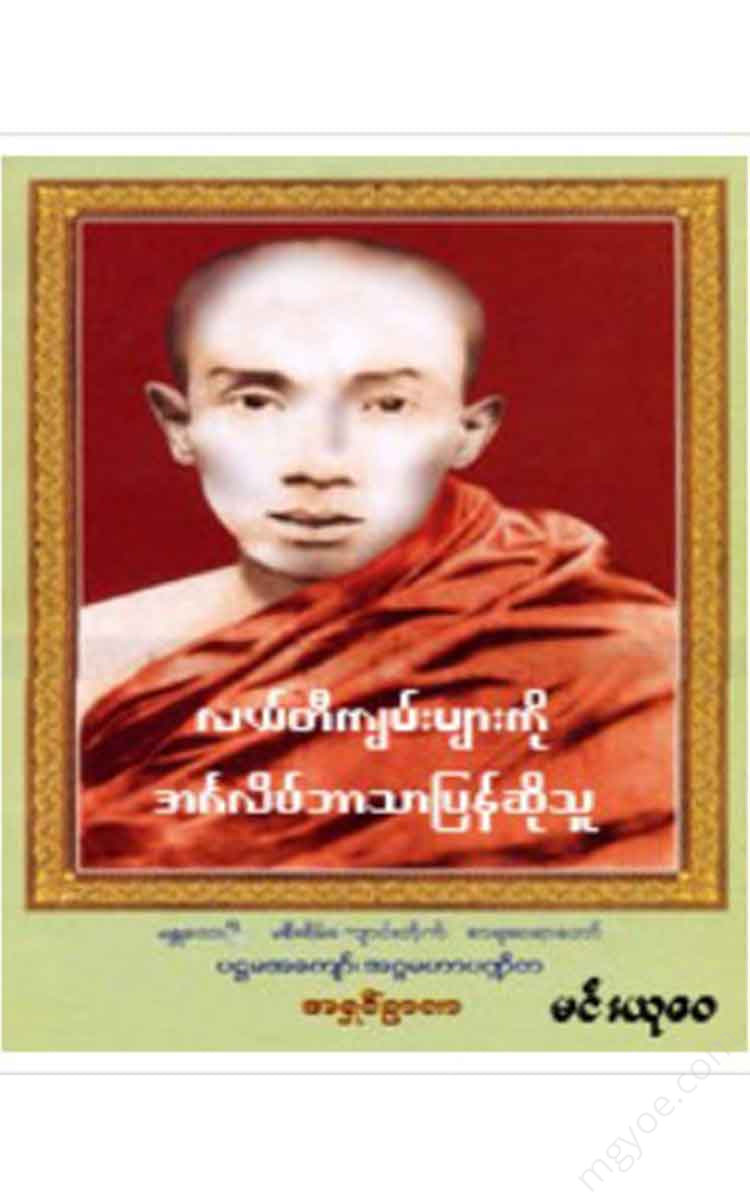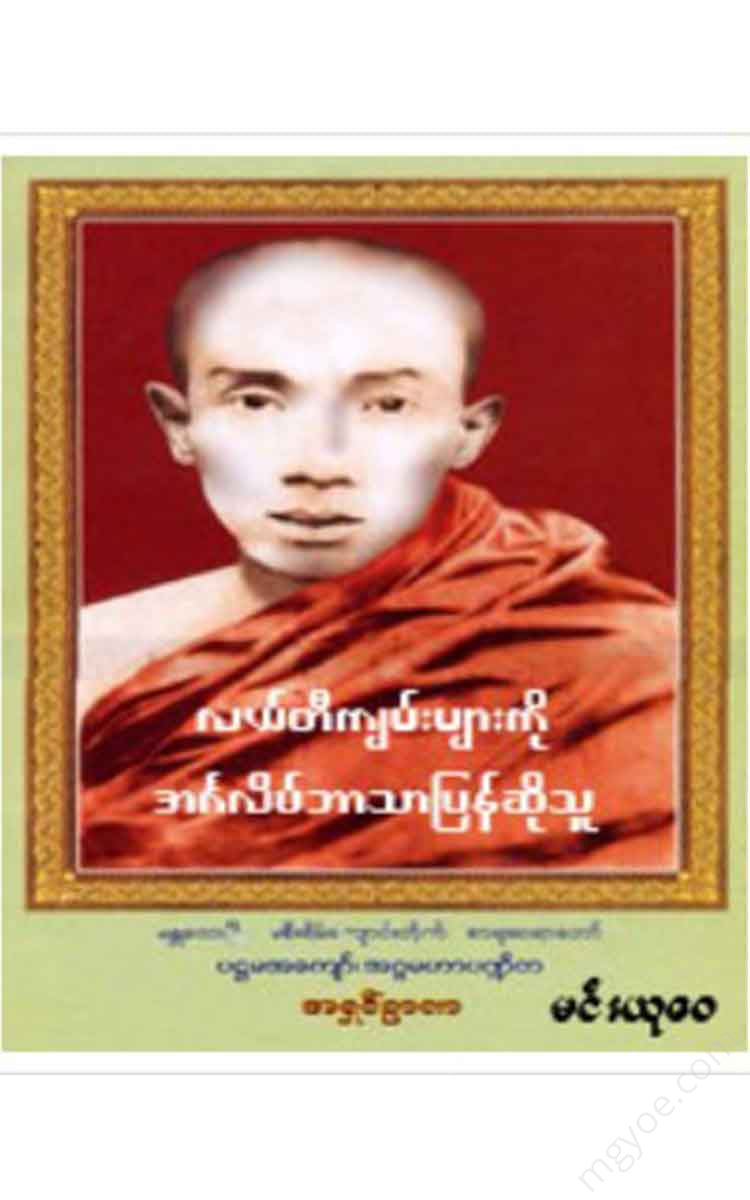Other Websites
Min Yu Wae - Sayadaw U Nana, who translated the Lati scriptures into English
Min Yu Wae - Sayadaw U Nana, who translated the Lati scriptures into English
Couldn't load pickup availability
It was more than 80 years ago during the British era.
One day, a group of friends from a high school in Yangon went on a pilgrimage to Kyaik Htiyo. When they arrived at Kyaik Htiyo, a beautiful place surrounded by forests and streams, the students were so happy that they sang in awe.
Among them, a student named “Maung Ba Nyein” could not sing like his friends, and was not happy. He was sharing the Dhamma with them, citing the peaceful and tranquil Kyaik Htiyo area. Therefore, he did not accompany his friends when they visited the area. He did not leave the Kyaik Htiyo Pagoda. He would often pay homage and offer prayers.
When the time came, they descended from Kyaik Htiyo Mountain and reached the foot of the mountain, and Maung Ba Nyein and his friends did not return to Yangon. They went with a monk they met on the way to Maung La Myaing. Then, when they reached Kyaukchan village in Apaung Township, they put on the robes at the monk of Nyaung Pin Kone. That day was the 10th day of the full moon of Tagu in 1265 (April 21, 1930). At that time, Maung Ba Nyein was only about 20 years old.
Maung Ba Nyein is none other than... the first Kyaw Sayadaw U Nana, who will become famous in the religious world in the future.
Maung Ba Nyein was very intelligent. He came first in every class. He also passed the 4th grade exam. He also won the eighth scholarship. Teacher U Ya Kyaw liked him and appointed him as a 4th grade teacher. At that time, Maung Ba Nyein was only 11 years old.
Mother Daw An Thi had to move to Yangon with her children due to her job situation. Then, her son Maung Ba Nyein was sent to a government high school. At that time, Maung Ba Nyein was 14 years old and Maung Ba Nyein had always been the first in every class in high school. | He not only passed the 7th grade exam, but also won a scholarship.
When Maung Ba Nyein was a high school student, he and his friends used to go to Shwedagon Pagoda every night to offer fire. Then, since Shwedagon Pagoda was far from where he lived, he moved to Sule Pagoda, which was close to his house, to offer fire. After offering fire, he and a group of friends started the Sule Mee Tun Association. At that time, they could only offer fire with wax and oil lamps, so they called it “Sule Mee Tun Association”. Later, when they could offer fire with flashlights, the association became known as “Sule Mee Tun Association”.
When Maung Ba Nyein reached the 9th grade, the British government issued a new order. It was an order that students should respect the white-faced headmaster and teachers of the school just as they respect the Buddha, the Dhamma, and the Three Jewels. At this, the students led by Maung Ba Nyein were dissatisfied and boycotted the school. Eventually, the authorities revoked the order. Only then did Maung Ba Nyein return to school.
Maung Ba Nyein took the 9th grade exam at the age of 19. | At that time, there were 10th grade. 9th grade was the highest grade in high school. Since there was no university in Myanmar, those who passed the 9th grade were examined by the University of Calcutta. Those who passed the 9th grade were eligible to enter the University of Calcutta, so it was also called the entrance exam (entrance exam).
Maung Ba Nyein passed the 9th grade university entrance exam successfully. Before the results were released, he went to Kyaik Htee Yoe to visit the Buddha, where he received the Dhamma and took the robe.
Maung Ba Nyein, a monk in Kweechan village, had become a monk at the age of 14 before he wore the robe. At that time, he took the title of Shin Nana. Now, when he wears the robe, he also takes the title of Shin Nana.
After spending some time in Kweechan village, the monk Shinna returned to Yangon to seek permission from his mother to become a monk. He stayed for a while in the Zayat, the monastery of the Mee Tun Association at the Sule Pagoda. At that time, the examination results had come out. His mother and friends were overjoyed to learn that Maung Ba Nyein had achieved outstanding results.
At that time, English speakers were rare. Therefore, even if you passed the fourth or fifth grade, you could easily get a writing job. If you passed the ninth grade, you could easily get the position of a city manager (or equivalent).
Therefore, friends close to the mother came to visit and talked about various things. They explained that the path to prosperity and prosperity in the world was straight and smooth.
Shin Nara did not desire worldly wealth. He wanted to live his whole life as a monk. Finally, unable to stop his son, his mother allowed him. Thus, Shin Nara converted from a hermit to a monk on the 1st day of the full moon of the Nayon month, 1266 (May 29, 1904) at the feet of Shwe Gondaing Sayadaw Buddha. Then, he bowed down to the feet of Shwe Gondaing Sayadaw Buddha and the head monk U Shan, and learned the monk's precepts and the Vinaya. He also learned the basic literature and teachings.
About a year later (1267, in the month of Tasangmone), Ashin Nana went to Mandalay to continue his study of the scriptures. In Mandalay, he studied under the guidance of the great monk Moe Kaung, the great monk Taki, and the first monk U Thuriya. U Thuriya was a monk who would later become the great monk Ma Soyung.
In 1268, U Nana approached the great monk U Ganda of Pakokku and studied. Then, from 1269 to 1271, he moved with U Thuriya to Wachet village in Sagaing and continued his studies under the great monk Pagoda.
In 1272, at the request of the monks of the Masoyang monastery, U Thuriya moved to the Pali Nayapada monastery in Masoyang. U Nana also accompanied him. That year, U Nana entered the first grade of the first grade and ranked first in the whole of Burma, and in 1273, he was awarded the First Kyaw title. At that time, U Nana was only 28 years old.
After being awarded the first Kyaw title, U Nana sent letters to the monks day and night. On the other hand, he compiled scriptures.
Sayadaw U Nana first translated the Janaka Jataka from the original Pali into Burmese. Then, at the request of the abbot of the monastery, he translated the Payasirajanaya Sutta into Burmese.
In 1291 (1930), the concerned authorities conferred the title of Agga Maha Pandita on Sayadaw U Thuriya. Shortly thereafter, Sayadaw U Thuriya and Sayadaw U Nana went on a pilgrimage to India and Ceylon. The pilgrimage group was also accompanied by some lay people. Since traveling abroad could only be done in English, Sayadaw U Nana, who knew English, had to lead the way.
Sayadaw U Nana was not only proficient in English, but also excellent. Therefore, he translated some of the books written by Sayadaw Leti into English. This was requested by the prominent Buddhist missionary association of that time.
Hetu Pissaya - The relation by law of root
Arammanapissaya - The relation of object
The relation of dominance
Ananta Pasaya - The relation of contiguity
Samanantapikasaya - The relation of immediate contiguity
The relation of Co-existence
The relation of reciprocity
The relation of dependence
Upanissaya -The relation of Sufficing condition
The relation of pre-existence
The relation of post-existence
The relation of habitual recurrence
The relation of Kamma
Vipakkapisaya - The relation of effect
The relation of Food
The relation of control
The relation of Jhana
Magga Pissaya - The relation of Path
Sampayuttapissaya - The relation of association
Vippāyuttapissaya - The relation of dissociation
Atthipitasaya - The relation of presence
The relation of absence
The relation of abeyance
Avigatapissaya - The relation of continuance
Sayadaw U Nana was not only an excellent English speaker but also a deep understanding of the Buddha's teachings. That is why he was able to translate them so successfully. Later, Ashin Aggawansaka, a disciple of Sayadaw U Nana from Ma Soyong, translated the text of the Leti Sayadaw's book into Burmese Nissaya. It is stated that the translation was based on the teachings of Sayadaw Ashin Nana. Sayadaw U Nana was a great person who played an important role in spreading the Buddha's teachings to the world.
Sayadaw U Nana not only translated the three books into English, but also wrote and solved problems in English when foreigners presented them with unclear questions about Buddhism.
At that time, European scholars had written to the Venerable Letti Sayadaw to compile a Pali dictionary that was especially needed by those who studied Buddhist literature. At that time, the Venerable Letti was over 70 years old. Although he had the intellectual ability to compile the dictionary, he was too old to work. Therefore, he looked for people who could compile it on his behalf. Finally, he contacted the monks of the Ma Soyong Monastery and assigned them the task. Thus, the Ma Soyong Nayaka Committee formed the Pali Dictionary Compilation Committee with the Venerable Letti Sayadaw as the head. The committee consisted of the first chairman of the Ma Soyong Monastery, the first chairman of the Sasanayupaya Kyaung Sayadaw, the second chairman of the Ma Soyong Monastery Ten other monks are members. More than 30 basic monks and talented students also contribute.
The monks who wrote the Pali dictionary wrote every day. After writing, they worked hard to write and edit the dictionary every free time. In a year, they received a commission to print 4 books. After that, they continued to edit and complete the manuscript, which was about 3000 pages long. However, due to various difficulties, only 1,034 pages were printed and published as a book. The volumes that were published, the authors responsible for writing them, and the years of publication are: Part-1, Volume-1, Sayadaw U Somabithiri (1290-1290). Part-2, Volume-1, Sayadaw U Thuriya (1289). Part-3, Volume-1, Sayadaw U Nana (1298). Part-4, Volume-1, Sayadaw U Razi Naman (1294).

